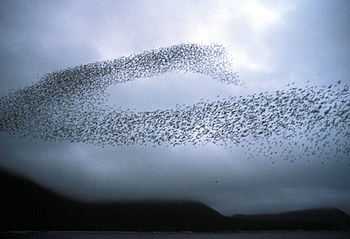Swarming motility
Swarming motility is a rapid (2–10 μm/s) and coordinated translocation of a bacterial population across solid or semi-solid surfaces. This type of motility is an example of an emerging concept in microbiology : bacterial multicellularity. Swarming motility was first reported by Jorgen Henrichsen[1] and has been mostly studied in genus Serratia,[2][3] Salmonella,[4] Aeromonas,[5] Bacillus,[6] Yersinia,[7] Pseudomonas,[8][9][10][11][12] Proteus,[13] Vibrio[14][15] and Escherichia.[16][17]
This multicellular behavior has been mostly observed in controlled laboratory conditions and relies on two critical elements: 1) the nutrient composition and 2) viscosity of culture medium (i.e. % agar).[4] One particular feature of this type of motility is the formation of dendritic fractal-like patterns formed by migrating swarms moving away from an initial location. Although the majority of species can produce tendrils when swarming, some species like Proteus mirabilis do form concentric circles motif instead of dendritic patterns.

Biosurfactant, quorum sensing and swarming
In some species, swarming motility requires the self-production of biosurfactant to occur.[4][18] Biosurfactant synthesis is usually under the control of an intercellular communication system called quorum sensing. Biosurfactant molecules are thought to act by lowering surface tension, thus permitting bacteria to move across a surface.
Cellular differentiation
Swarming bacteria undergo morphological differentiation that distinguish them from their planktonic state. Cells localized at migration front are typically hyperelongated, hyperflagellated and grouped in multicellular raft structures.[10][11][19]
Ecological significance
The fundamental role of swarming motility remains unknown. However, it has been observed that active swarming bacteria of Salmonella typhimurium shows an elevated resistance to certain antibiotics compared to undifferentiated cells.[20]
References
- ↑ Henrichsen, J (1972). "Bacterial surface translocation: a survey and a classification". Bacteriological reviews 36 (4): 478–503. PMC 408329. PMID 4631369.
- ↑ Alberti, L; Harshey, RM (1990). "Differentiation of Serratia marcescens 274 into swimmer and swarmer cells". Journal of bacteriology 172 (8): 4322–8. PMC 213257. PMID 2198253.
- ↑ Eberl, L; Molin, S; Givskov, M (1999). "Surface Motility of Serratia liquefaciens MG1". Journal of bacteriology 181 (6): 1703–12. PMC 93566. PMID 10074060.
- ↑ 4.0 4.1 4.2 Harshey, Rasika M. (1994). "Bees aren't the only ones: swarming in Gram-negative bacteria". Molecular Microbiology 13 (3): 389–94. doi:10.1111/j.1365-2958.1994.tb00433.x. PMID 7997156.
- ↑ Kirov, S. M.; Tassell, B. C.; Semmler, A. B. T.; O'Donovan, L. A.; Rabaan, A. A.; Shaw, J. G. (2002). "Lateral Flagella and Swarming Motility in Aeromonas Species". Journal of Bacteriology 184 (2): 547–55. doi:10.1128/JB.184.2.547-555.2002. PMC 139559. PMID 11751834.
- ↑ Kearns, Daniel B.; Losick, Richard (2004). "Swarming motility in undomesticated Bacillus subtilis". Molecular Microbiology 49 (3): 581–90. doi:10.1046/j.1365-2958.2003.03584.x. PMID 12864845.
- ↑ Young, GM; Smith, MJ; Minnich, SA; Miller, VL (1999). "The Yersinia enterocolitica Motility Master Regulatory Operon, flhDC, Is Required for Flagellin Production, Swimming Motility, and Swarming Motility". Journal of bacteriology 181 (9): 2823–33. PMC 93725. PMID 10217774.
- ↑ Deziel, E.; L�pine, F; Milot, S; Villemur, R (2003). "rhlA is required for the production of a novel biosurfactant promoting swarming motility in Pseudomonas aeruginosa: 3-(3-hydroxyalkanoyloxy)alkanoic acids (HAAs), the precursors of rhamnolipids". Microbiology 149 (Pt 8): 2005–13. doi:10.1099/mic.0.26154-0. PMID 12904540.
- ↑ Tremblay, Julien; Richardson, Anne-Pascale; L�pine, François; D�ziel, Eric (2007). "Self-produced extracellular stimuli modulate the Pseudomonas aeruginosa swarming motility behaviour". Environmental Microbiology 9 (10): 2622–30. doi:10.1111/j.1462-2920.2007.01396.x. PMID 17803784.
- ↑ 10.0 10.1 K�hler, T; Curty, LK; Barja, F; Van Delden, C; Pech�re, JC (2000). "Swarming of Pseudomonas aeruginosa Is Dependent on Cell-to-Cell Signaling and Requires Flagella and Pili". Journal of bacteriology 182 (21): 5990–6. doi:10.1128/JB.182.21.5990-5996.2000. PMC 94731. PMID 11029417.
- ↑ 11.0 11.1 Rashid, MH; Kornberg, A (2000). "Inorganic polyphosphate is needed for swimming, swarming, and twitching motilities of Pseudomonas aeruginosa". Proceedings of the National Academy of Sciences of the United States of America 97 (9): 4885–90. doi:10.1073/pnas.060030097. PMC 18327. PMID 10758151.
- ↑ Caiazza, N. C.; Shanks, R. M. Q.; O'Toole, G. A. (2005). "Rhamnolipids Modulate Swarming Motility Patterns of Pseudomonas aeruginosa". Journal of Bacteriology 187 (21): 7351–61. doi:10.1128/JB.187.21.7351-7361.2005. PMC 1273001. PMID 16237018.
- ↑ Rather, Philip N. (2005). "Swarmer cell differentiation in Proteus mirabilis". Environmental Microbiology 7 (8): 1065–73. doi:10.1111/j.1462-2920.2005.00806.x. PMID 16011745.
- ↑ McCarter, L.; Silverman, M. (1990). "Surface-induced swarmer cell differentiation of Vibrio parahaemoiyticus". Molecular Microbiology 4 (7): 1057–62. doi:10.1111/j.1365-2958.1990.tb00678.x. PMID 2233248.
- ↑ McCarter, Linda L. (2004). "Dual Flagellar Systems Enable Motility under Different Circumstances". Journal of Molecular Microbiology and Biotechnology 7 (1–2): 18–29. doi:10.1159/000077866. PMID 15170400.
- ↑ Harshey, RM; Matsuyama, T (1994). "Dimorphic transition in Escherichia coli and Salmonella typhimurium: surface-induced differentiation into hyperflagellate swarmer cells". Proceedings of the National Academy of Sciences of the United States of America 91 (18): 8631–5. doi:10.1073/pnas.91.18.8631. PMC 44660. PMID 8078935.
- ↑ Burkart, M; Toguchi, A; Harshey, RM (1998). "The chemotaxis system, but not chemotaxis, is essential for swarming motility in Escherichia coli". Proceedings of the National Academy of Sciences of the United States of America 95 (5): 2568–73. doi:10.1073/pnas.95.5.2568. PMC 19416. PMID 9482927.
- ↑ Daniels, Ruth; Vanderleyden, Jos; Michiels, Jan (2004). "Quorum sensing and swarming migration in bacteria". FEMS Microbiology Reviews 28 (3): 261–89. doi:10.1016/j.femsre.2003.09.004. PMID 15449604.
- ↑ Julkowska, D.; Obuchowski, M; Holland, IB; S�ror, SJ (2004). "Branched swarming patterns on a synthetic medium formed by wild-type Bacillus subtilis strain 3610: detection of different cellular morphologies and constellations of cells as the complex architecture develops". Microbiology 150 (Pt 6): 1839–49. doi:10.1099/mic.0.27061-0. PMID 15184570.
- ↑ Kim, W.; Killam, T.; Sood, V.; Surette, M. G. (2003). "Swarm-Cell Differentiation in Salmonellaenterica Serovar Typhimurium Results in Elevated Resistance to Multiple Antibiotics". Journal of Bacteriology 185 (10): 3111–7. doi:10.1128/JB.185.10.3111-3117.2003. PMC 154059. PMID 12730171.
